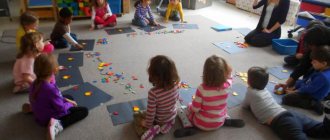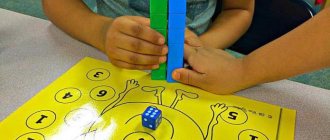Dawn and Dusk
It is very important for children to connect new concepts with specific examples. Let’s say that a child will quickly learn the word “day” if it is associated with the visible sun in the sky. That is, abstract symbols and concepts are not yet available to children’s brains. Therefore, in kindergarten manuals you can find a lot of visual material for teaching children.
Day/night is understandable and easy for the child to understand. It is more difficult to explain what morning is and what evening is. Why are they called differently, and what is their fundamental difference? To do this, show the child pictures that depict human activity.
Let's say the morning differs from the day in that you need to brush your teeth and wash your face after sleep. The picture clearly shows this. During the day, children walk outside and play on the playground, and in the evening they play at home or in the kindergarten. Thus, the processes of activity are organized in the child’s mind and a logical chain “time of day - actions” is formed.
Category: Clocks and time - online games and exercise machines
Interactive clock with moving hands. The arrows are connected to each other. The simulator will help you learn the time on the clock.
Read more
A simulator that ends the series of educational games in the “Time” section. You will need to move the clock hands with the mouse to the specified time. You can see the correct answer if there is an error. 30 tasks of our online game will help to perfectly reinforce the topic “Time on the clock”
Read more
Interactive teaching aid - a game in which we will teach the minutes and hours of the afternoon. The game has 2 sections - minutes and hours, each of which has a study mode and 2 tests.
Read more
We learn time on an electronic clock and a clock with a dial at the same time. Set the time on the electronic clock and click the “Show” button. This manual can also be used for self-testing.
Read more
Interactive manual - game. Move the hour hand and you will see the time of day change: morning, afternoon, evening, night.
Read more
Learn time with our extraordinary clock! You can move the clock hands with the mouse and set your own time. There are hints that you can turn off and use for self-testing.
Read more
Source: https://kid-mama.ru/category/igry-i-trenazhery/chasy-i-vremya/
Fixing the material
In order for the studied material to become embedded in the child’s memory, it is necessary to have daily conversations on a given topic. For example, you ask a child:
- What did you do in kindergarten this morning?
- What did you have for breakfast this morning?
- did you play on the playground during the day?
- What did you have for lunch this afternoon?
Here it is important to associate the time of day with food intake: breakfast - morning, lunch - afternoon, dinner - evening. These are new concepts for the baby, but he will easily learn them using specific examples. In everyday communication with your baby, mention the names of meals more often (let's go to dinner, the bunny wants breakfast, etc.).
You can also use visual material in pictures. Let’s say you put a picture of “evening” in front of your child and ask about the time. It is important to establish a dialogue with the baby and encourage him to tell a story using leading questions. Let's say you ask a child: is it evening or day? After answering, you ask why he says this?
Morning
Important! After understanding the differences between evening/morning/day/night, it is necessary to explain that they make up the day and are part of them. Just like a bear and a bunny have a common name - toys.
Night
The first basics of studying time
How to teach a preschooler to understand a clock?
Abstract thinking appears only at school age; before that, children cannot adequately perceive it, so if something doesn’t work out, don’t be upset. You need to start with the most extensive and simple concept - an explanation of the seasons, seasonality. By the way, you can read about it here. Next, you need to move on to studying the months and days of the week.
But, first things first. First, you need to explain the main properties of time:
- the time in a day is repeated in a circle (for clarity, there is a round dial),
- Time is fleeting and nothing can be returned back.
There seem to be two such serious oppositions, but nevertheless, this needs to be explained. Take an electronic watch and a simple mechanical one.
The round dial is a symbol of repetition in a circle (it is morning now and tomorrow will be morning and yesterday began in the morning).
And the numbers replacing each other on an electronic clock symbolize time “escaping into eternity.” This can even be demonstrated by an hourglass.
Is the child already 2-3 years old?
Start by discussing his age. Now you are 2 years old, in a year you will be 3, and in two years you will be 5... and when your brother goes to school, you will be 6 years old. The child should have some guidelines from which he will build. Or in a slightly different direction: a year ago you knew how to do this, now you can do “this”..., and in a year you will be able to do something else.
A second, no a minute
To make it easier for the baby to navigate such complex concepts as hour and minute with seconds. For each explanation, you need to come up with an action that will coincide in duration with the interval being explained. For example, stamping your foot takes a second, walking from a room to some object takes a minute, but walking from home to kindergarten (if it’s far away) takes an hour.
Don’t rush to explain what the arrow means in this or that place, it doesn’t matter now, teach a small child to perform all the actions sequentially in time. First - breakfast, then - a game, then - a walk, etc. And break each of these events into points and emphasize it to the child. Breakfast: we sit at the table - take a spoon - eat porridge - drink milk - wash, etc. The same with the rest of the “large” actions, we break everything up. Be sure to indicate: in the morning we will have breakfast, in the afternoon we will sleep and go for a walk, and in the evening dad will come home from work and we will have dinner. This way you will instill in your child the simplest temporal concepts: what happens during the day and that tomorrow everything will happen again. Those. within one day nothing repeats itself, and tomorrow everything starts anew.
Be sure to accompany your actions with words.
Future First we'll eat, then we'll take a walk. First we'll play dominoes, then a puzzle, etc.
The present
Now let's go eat and then go for a walk. Now we are playing dominoes, and then we will put together a puzzle.
Past
First we ate, and then we walked. First we played dominoes, and then we put together a puzzle.
Show didactic pictures that help understand the sequence of actions taking place. Describe what is depicted there, ask the child to talk about the image.
making a training dial
How to teach your child to understand which hand shows the hour and which hand shows the minutes?
Make a homemade dial, with the help of which your child will learn to understand how the hands move, what numbers are present and what it all means. This certainly helps to develop from a mathematical point of view. The child develops a concept of numbers and may even learn to count. For older children, it will be easy to learn adding numbers. Let's get down to business, print out the dial, let the child decorate it, he also wants to be a full-fledged participant in the creative process. Cut in a circle; if the child confidently wields scissors, trust him to do this; no, protect him from this. Cut out arrows from thick cardboard: small and large. If you have hands from an old clock, that’s great. Make a hole in the center of the dial. It’s not bad if the dial is glued to cardboard, it will be much more durable. Screw the hands to the dial using a bolt and nut. It turns out to be a very convenient guide.
Where to begin?
1. Explain the meaning of the short and long arrows. 2. Start with the clockwise hand (you can remove the long one for now, so as not to confuse you): what number it is on and how much it shows.
Well, we wanted to correlate this time with the action taking place in the baby’s life (7 am – the child gets up, 8 am – comes to kindergarten, etc.). 3.
Development of thinking
When the difference between morning and evening is clearly imprinted in the baby’s mind, you can go further - activate his thinking. To do this, you need to show pictures depicting human activities and ask what time of day they do such activities.
Things to do for the day
Questions should be asked like this:
- When do stars appear in the sky - during the day or at night?
- When do the kids have lunch - in the afternoon or in the evening?
- When do they do exercises - in the morning or in the afternoon?
- When does the sun shine in the sky - during the day or at night?
You can come up with such questions yourself, encouraging your child to talk and operate with the basic concepts of time. You can also ask your child what the sun does in the morning/night/evening.
Night sleep
MAGAZINE Preschooler.RF
Lesson “Parts of the day, daily routine”for older preschoolers with mental retardation Topic: “Parts of the day, daily routine”
Goal: Generalization and consolidation of knowledge about the daily routine, according to the parts of the day"
Tasks:
Educational:
- Consolidation of knowledge about the parts of the day, correlation with the daily routine.
- Teach children to distinguish parts of the day and determine their sequence.
- Expansion of passive and active vocabulary
Correctional and developmental:
- Development of auditory attention.
- Development of oral coherent speech, updating of passive vocabulary.
- Development of visual perception.
Educational:
- Develop the ability to collaborate in a team.
- Develop skills of cultural behavior in joint classes.
- Develop the ability to listen and independently follow instructions.
Equipment and materials: two sets of pictures depicting parts of the day, a set of pictures with the daily routine, flannelgraph, colored pencils for each child, black and white story pictures with the daily routine.
Progress of the lesson:
Hello guys! I see that you have not all woken up yet. What should we do now? We need to exercise!
Every day we do exercises in the morning. We all really like to do everything in order.
We walk merrily, we raise our hands, we squat and stand up, we jump and gallop.
- Guys, tell me, what time of day is it now? That's right, it's morning now. Why do you think so? The sun is rising, the birds began to sing, we all woke up. And let's remember together what we always do in the morning: we wake up, wash our face, brush our teeth, do exercises and have breakfast (the corresponding pictures hang on the board).
Look at this picture (Day). What time of day is it? That's right, day. The sun is already high. Guys, what do you usually do during the day? We go for a walk, play, draw, sculpt, study.
Repeat this poem after me:
We repeat everything we know, And we sing with pleasure, And we read poetry with all our might, Or we remember fairy tales.
Now let's remember what comes after the day. That's right, evening is coming. The sun goes down, the flowers close their buds, and it gets dark outside. What are you doing in the evening? You come home from kindergarten, play calm games, watch your favorite cartoons, have dinner with the whole family and get ready for bed. And it's true
This time is given to us For a fun movie, For riding a horse And on daddy's back.
The moon is floating in the sky, Mom is calling for dinner.
And then comes... That's right, night comes. What do you do at night? At night we sleep.
This time is sleep time, The pine tree is sleeping outside the windows. The children fell into a sweet dream, tomorrow they will go back to kindergarten.
Now take colored pencils and color the pictures in order: morning, afternoon, evening, night.
Guys, today we learned to identify the parts of the day and found out what our routine is at each time of the day. What part of the day do you like best? Why?
Guys, you've been doing a good job, and now it's time to relax. Class over!
| Next > |
Tomorrow and yesterday
The categories of time “tomorrow, today, yesterday, the day after tomorrow” are not yet accessible to the baby’s understanding, because they are not associated with activity and tactile/visual sensations. To teach your child to distinguish between these concepts, it is necessary to start from activity. For example, the kid remembered well the trip to the circus. How can this event be used to teach time? Must speak:
- tomorrow we will go to the circus;
- today we watched tigers at the circus;
- where were we yesterday?
The child will understand the concept of “yesterday” faster, because he remembers yesterday’s events. It is more difficult to explain and understand the word “tomorrow”. To do this, tell us when “tomorrow” comes:
- first the baby should go to bed at night;
- the next morning “tomorrow” will come.
Gradually, the baby will begin to understand the difference between “today, tomorrow and yesterday.” The main thing is that you should not rush your child into mastering new (abstract) concepts and get angry at his lack of understanding. Over time, he will master everything.




